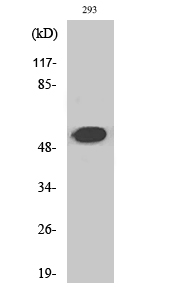Plasminogen Polyclonal Antibody
- Catalog No.:YT3786
- Applications:WB;IHC;IF;ELISA
- Reactivity:Human;Rat;Mouse;
- Target:
- Plasminogen
- Fields:
- >>Neuroactive ligand-receptor interaction;>>Complement and coagulation cascades;>>Staphylococcus aureus infection;>>Influenza A
- Gene Name:
- PLG
- Protein Name:
- Plasminogen
- Human Gene Id:
- 5340
- Human Swiss Prot No:
- P00747
- Mouse Swiss Prot No:
- P20918
- Immunogen:
- Synthesized peptide derived from the Internal region of human Plasminogen.
- Specificity:
- Plasminogen Polyclonal Antibody detects endogenous levels of Plasminogen protein.
- Formulation:
- Liquid in PBS containing 50% glycerol, 0.5% BSA and 0.02% sodium azide.
- Source:
- Polyclonal, Rabbit,IgG
- Dilution:
- IHC: 100-300.WB 1:500 - 1:2000. ELISA: 1:40000.. IF 1:50-200
- Purification:
- The antibody was affinity-purified from rabbit antiserum by affinity-chromatography using epitope-specific immunogen.
- Concentration:
- 1 mg/ml
- Storage Stability:
- -15°C to -25°C/1 year(Do not lower than -25°C)
- Other Name:
- PLG;Plasminogen
- Observed Band(KD):
- 90kD
- Background:
- The protein encoded by this gene is a secreted blood zymogen that is activated by proteolysis and converted to plasmin and angiostatin. Plasmin dissolves fibrin in blood clots and is an important protease in many other cellular processes while angiostatin inhibits angiogenesis. Defects in this gene are likely a cause of thrombophilia and ligneous conjunctivitis. Two transcript variants encoding different isoforms have been found for this gene.[provided by RefSeq, Dec 2009],
- Function:
- catalytic activity:Preferential cleavage: Lys-|-Xaa > Arg-|-Xaa; higher selectivity than trypsin. Converts fibrin into soluble products.,disease:Defects in PLG are a cause of thrombophilia [MIM:188050]; a form of recurrent thrombosis.,disease:Defects in PLG may be associated with ligneous conjunctivitis [MIM:217090]. Ligneous conjunctivitis is an unusual and rare form of chronic conjunctivitis, characterized by chronic tearing and redness of the conjunctivae. Initially, pseudomembranes form on the palpebral surfaces which then progress to thick nodular masses that replace the normal mucosa. Because the pseudomembranes have a woodlike consistency, the disease is termed "ligneous" conjunctivitis. The disease may be associated with pseudomembranous lesions of other mucous membranes in the mouth, nasopharynx, trachea, and female genital tract.,domain:Kringle domains mediate interaction with
- Subcellular Location:
- Secreted . Locates to the cell surface where it is proteolytically cleaved to produce the active plasmin. Interaction with HRG tethers it to the cell surface.
- Expression:
- Present in plasma and many other extracellular fluids. It is synthesized in the liver.
- June 19-2018
- WESTERN IMMUNOBLOTTING PROTOCOL
- June 19-2018
- IMMUNOHISTOCHEMISTRY-PARAFFIN PROTOCOL
- June 19-2018
- IMMUNOFLUORESCENCE PROTOCOL
- September 08-2020
- FLOW-CYTOMEYRT-PROTOCOL
- May 20-2022
- Cell-Based ELISA│解您多样本WB检测之困扰
- July 13-2018
- CELL-BASED-ELISA-PROTOCOL-FOR-ACETYL-PROTEIN
- July 13-2018
- CELL-BASED-ELISA-PROTOCOL-FOR-PHOSPHO-PROTEIN
- July 13-2018
- Antibody-FAQs
- Products Images

- Immunohistochemical analysis of paraffin-embedded Human testis. 1, Antibody was diluted at 1:200(4° overnight). 2, High-pressure and temperature EDTA, pH8.0 was used for antigen retrieval. 3,Secondary antibody was diluted at 1:200(room temperature, 30min).

- Immunohistochemical analysis of paraffin-embedded Human testis. 1, Antibody was diluted at 1:200(4° overnight). 2, High-pressure and temperature EDTA, pH8.0 was used for antigen retrieval. 3,Secondary antibody was diluted at 1:200(room temperature, 30min).



